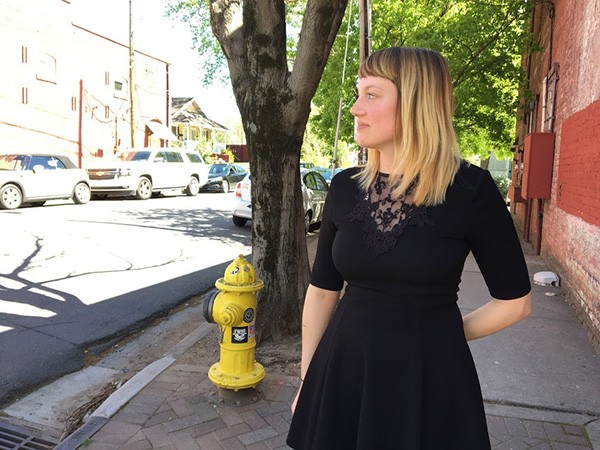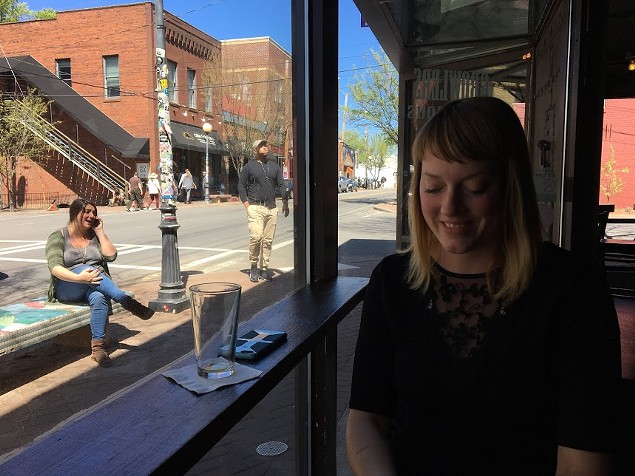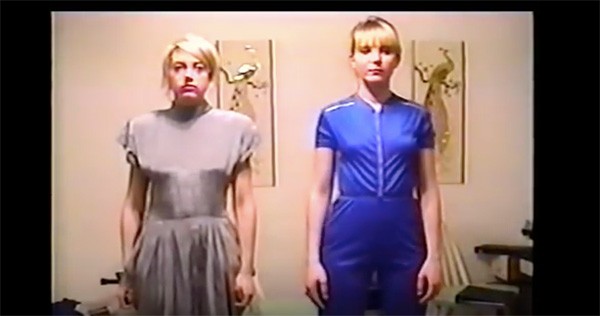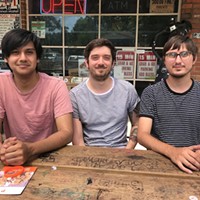
Photo of Angela Saylor by Mark Kemp
When Angela Saylor found out the electronic musician Joey Casio was among the 36 people who died in the tragic Ghost Ship warehouse fire in Oakland, Calif., late last year, it rocked her world. The blaze had swept though a building where numerous artists lived and worked. Casio, who released music on the famed Olympia, Wash., indie label K Records, had been Saylor's friend in another lifetime.
Casio was just 36 at the time of his death. Saylor, a fellow electronic artist who records and performs as Minthill, is 36, too.
"I hadn't talked to him or seen him in years," Saylor says of her old running buddy. "But I just felt like I wanted to do something, and I thought, 'Why not here? Why not Charlotte?"
In January, Saylor organized Keepsake: A Musical Memorial Benefit, at Snug Harbor. The proceeds went to the Oakland Fire Relief Fund. "Charlotte may be far away from Oakland, and maybe it's a little removed from that [West Coast scene]," she continues, "but I tried to keep it mostly electronic artists. I really wanted to have a night where we only focused on that."
Saylor is perched on a stool by the front window at Growlers Pourhouse in NoDa, in a black lace swing dress, the sun casting a shadow over half her face in a way that gives her a pensive, moody look — not unlike the sound of her minimalist songs. When she's not working her corporate job in tech support, Saylor has begun to get out and peform again as Minthill. She brings her musical nom de plume back to Snug Harbor on Tuesday, April 18, along with two other Charlotte-area musicians, Joshua Cotterino and Dan Rico, and L.A.'s Banny Grove. And then, at 7 p.m. on Saturday, April 29, Minthill will perform a free show on the Intersection Stage at the BOOM Charlotte fringe music and arts festival in Plaza Midwood.
That's a lot of performing for an artist who's been relatively quiet for about six years. Part of what inspired Saylor to reactivate Minthill was the death of Casio. "He was a big influence on my music; he would give me tips, and we would do shows together all the time," she remembers. "He was just another cool weirdo electronic musician who did a lot of really interesting things that I'd never seen before. I had a lot of respect for him."
For a few years in the early 2000s and then again in the early 2010s, Saylor was a cool weirdo electronic musician who did a lot of really interesting things, too. Born in Salisbury and raised in a rural area outside Mint Hill, the small suburban community just southeast of Charlotte, she eventually left to attend Evergreen State College in Olympia. It was a different world from the rural South of her childhood.
Saylor, who as a high school teen would drive to Eastland Mall where she worked at Waves Records, always felt a little different from her peers in Mint Hill. She liked Britpop and gravitated to the experimental shoegaze sounds of '80s and '90s acts like the Cocteau Twins and My Bloody Valentine. When her mother would get angry at her, she would steal away to her bedroom and play melodies on her Yamaha keyboard. By graduation, Saylor had grown so weary of what she considered the "bigotry, hypocrisy and fake Southern hospitality" of North Carolina that she wanted to get as far away as possible.
She landed in Olympia just after the 1990s feminist riot grrrl movement — the musical scene launched by fiery, estrogen-powered punk bands like Bikini Kill, Bratmobile, Heavens to Betsy, and later Sleater-Kinney, the band cofounded by Portlandia's Carrie Brownstein. But by the time Saylor arrived in the small college town an hour southwest of Seattle, many of the riot grrrls had traded their electric guitars for electronics. Even Bikini Kill frontwoman Kathleen Hanna had formed the electroclash trio Le Tigre. So Saylor joined her own all-female electronic group, Muneca Chueca.
"The riot grrrl thing was pretty much over by the time I got out there," Saylor remembers, "but there were still all these women who were making music and who were empowered and were just doing weird music and playing in bands — like Tracy + the Plastics and Kanako [Pooknyw] from Broken Water."
It was an eye-opener for Saylor, who'd felt constrained in Charlotte's music scene. "Out there I just realized I could do anything — I could make any kind of music I wanted," she says. "I didn't have to play guitar or be in a conventional band."
Muneca Chueca recorded a pair of self-released albums (sadly, no longer available), and the group toured up and down the West Coast, getting write-ups in alternative media outlets like L.A. Weekly. One of their songs, "Julia's Diary: Stay Out," was a little mini-opera (think "A Quick One While He's Away," by the Who, but much more avant-garde) that combined operatic vocals and spoken-word with classical-like melodies, video-game sounds, and deep, throbbing basslines.
"We all played keyboards and drum machines, and dressed in different outfits for each show, so they were sort of themed shows each time we played," Saylor remembers.
The group didn't last long, but the experience empowered Saylor. When her bandmates graduated and left Olympia, she began recording her own music alone in her bedroom in the attic of a house on Plum Street. Her first Minthill release was an EP called Mintville, which she recorded on a 4-track using a Casio keyboard, Korg ElecTribe S and R series sampler and drum machine, and a couple of effects boxes. The Ohio vanity label Tolmie Terrapin Press put it out as a limited-edition, cassette-only release in March 2003, but it's now available on Minthill's Bandcamp page. The sound is minimalist, inspired by such early experimental and avant-garde forms as musique concrète and electroacoustic music, and influenced by artists ranging from composer Philip Glass to many of the artists on the British indie label Factory Records.
"Mintville was the first set of songs I wrote," Saylor says, "and the track 'Four Eighty Five' was one of the first songs that I remember being really, really proud of."
Gliding ruefully on a simple melody and beat, "Four Eighty Five" is a spare electronic painting daubed with impressionist lyrics in which Saylor expresses a longing for home: "It's a lasting impression the way the curtains frame your face," she sings, and then later, "I've been away for so long in my room with the door closed. / Four eighty five is pointless . . . All across the country I hear you saying it's internal."
Saylor was 3,000 miles away from the 485 beltway that passes through Mint Hill. And in the songs on Mintville, she was attempting to reconcile her childhood memories of growing up in the small community, listening to the Judds and Heart albums her mother liked, with her own young adulthood in one of the most progressive college towns in the U.S.
"At that point I'd been living in Olympia for three years, and I was having a difficult time," Saylor remembers. "I really loved it — I loved my freedom — but there was a part of me that felt like I had betrayed who I was, because I had gotten out and all my friends were all back here doing what they did. I was out there playing in bands and going on tour and going to college. It was such a different place. The Pacific Northwest is rainy and grey; I didn't have Bojangles, I didn't have sweet tea, I didn't have the idea of Southern hospitality."
She started missing all of that, idealizing it, but she didn't know exactly where those feelings were coming from. "It made absolutely no sense, because when I left the South, I hated it," Saylor says. "But being away from it and not surrounded by it anymore, I sort of created an idea of what Mint Hill could be, of what Mint Hill was to me. And that was when I started writing those songs. I guess I was trying to create another reality. Maybe I was trying to come to terms with it so I could feel OK about being from there."
From beginning to end, the Mintville EP is spectacular. "Four Eighty Five" is followed by the instrumental "Kindly Keep Track of Our Isolation," a tenser, more jittery and nervous track — eight minutes of hissing and sparkling, tempo and volume changes, buzzing and thundering sounds, with brush stokes of conventional keyboard playing. Unlike the other tracks, you could, in theory, dance to this one.
And then there's "Windmills & a Single Blister," a carnivalesque melody with spoken parts amid bell-like sounds and deep percussion, and the repeated words, "We haven't come here searching you out." The EP closes with "Finch Farm," which like the first track is a more conventional song — this one, a riot grrrl-inspired track with a basic melody and more impressionistic lyrics:
"There she was by that grave, oh no / She thought it was a grove / Whispering secrets to rocks and tree trunks — hollow, hollow, hollow, hollow, hollow. / You can't stop the future and I can't change the past / So while you're fighting for that next breath, I sit here waiting for my last. / So while I'm fighting for that next breath, you sit here waiting for your last."
"I was bringing all the memories from my past and putting it with elements of what I was going through at the time," Saylor says. "They were really strong emotions and feelings; it was like going through another adolescence. Here I was, in my early 20s, trying to make sense of like, 'I'm a completely different person now. I'm not that little girl from Mint Hill anymore. And what does that mean? And how can I reconcile that? I mean, I still had family here.'"
Creativity has been sporadic for Saylor. Although she continued writing and recording and sometimes releasing her music, she moved on. In the early 2010s Saylor was living in Seoul, South Korea, where she taught English as a second language. She loved the culture and environment, yet felt very, very alone. And so she wrote about it, and recorded more music.
One song, "Lucy Love," was inspired by a student who suddenly left the school where Saylor taught. It's also available on Bandcamp and was to be part of an album called Meadowhollow. The album was never completed, but the song, over pounding percussion, clanging bell sounds, hissing, and a vaguely Asian-like melody, includes the lyrics, "Lucy Love, Lucy Love, why did you go away?"
"When she moved away, it broke my heart," Saylor remembers.
"Lucy Love" is the last recording Saylor did as Minthill that's still available on Bandcamp. She eventually came back to Charlotte, did social work for nonprofits, taught, and landed her current job in tech support at AvidXchange. In her photo on the company's website, Saylor looks like any other corporate employee, not an artist who makes very avant-garde music.
Whatever that looks like.
But when fire ripped through that Oakland warehouse late last year, killing her friend, it reenergized Saylor. And her recent performances in Charlotte have inspired her to begin writing and recording new material.
"People here know that I make music and they know that I have music out there, but not many people here have ever seen me play," Saylor says. "So when that happened and I played out, people were like, 'Wow!'" She pauses, lets out a muted laugh, and continues: "And I mean, it wasn't really a wow, but I did start getting asked to do these different shows. So I thought, 'Well, maybe it's time to come out and do this again.'"
An early, rough take of a new track, "Nightflight" (not yet available), finds Saylor still working in a minimalist, Philip Glass-like vein — repeated, mesmerizing melody on keyboards. And she plans to re-issue her earlier works as a physical compilation along with visual artwork and video.
"I've never stopped doing music," Saylor says. "I've always done stuff for myself, and there's always been time in between things I've done. That's just how I work. And I've never really had a huge fan base or anything, so there's not big demand. But there are certain people who listen to my music and respect me as a musician. And that means a lot to me. I'm trying to have a little more self-esteem about it now."
She should. Because Minthill's music is worth hearing. And perhaps if Saylor continues to make sound paintings that evoke places and times and feelings that we all can idenify with in some way, then those certain people who respect her music will grow into a substantial fan base.
"Back then, you know, I didn't really know what exactly I was doing," Saylor says. "But now, it's a different time. I think there's more people making music kind of like this. So now, maybe, it can be more accepted."
Speaking of...
-

5 Ways to Socialize Even When You Are Stuck at Home
Oct 19, 2020 -

Proper Einsteins EP "Commercials" available now
Oct 1, 2020 -

Julia Funk Band JULIA on Madison Ward Show
Sep 17, 2020 - More »
Latest in Music Features
More by Mark Kemp
Calendar
-
NEEDTOBREATHE: THE CAVES WORLD TOUR @ PNC Music Pavilion
-
NEEDTOBREATHE - VIP Upgrades @ PNC Music Pavilion
-
 Killakoi @ Amos' Southend
Killakoi @ Amos' Southend -

LIVE MUSIC FRIDAYS: TRACE CASANOVA @ Elizabeth Parlour Room at Hooligans FC
-
We Three @ The Underground
-
Hayley Williams topless photo circulates
Topless photo of Paramore's Hayley Williams hits the Internet.
-
St. Vincent drops jaws at The Fillmore
90-minute set was worth the wait after March show was postponed.
-
Canadian Dan Mangan's music takes an award-winning shift
Despite winning two Juno awards, the musician remain humble























